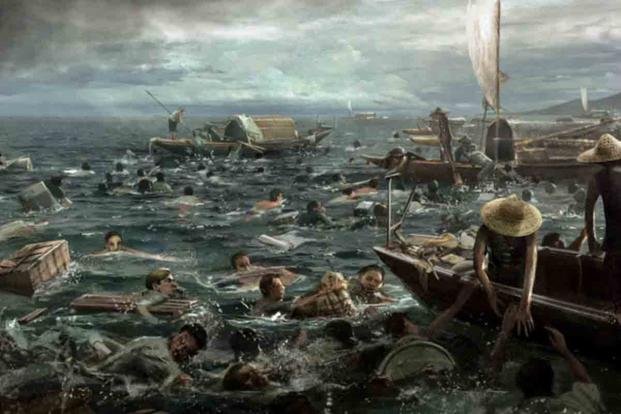The Lisbon Maru was a Japanese cargo ship that was converted into an armed troop ship during World War II. So when it was torpedoed by the USS Grouper on Oct. 1, 1942, it would have been a legitimate target, had it only been carrying 700 Japanese troops. Tragically, on that particular voyage, it was also carrying more than 1,800 British prisoners of war captured in Hong Kong in December 1941.
Filmmaker Fang Li was in the process of making another movie in 2014 when he came across Chinese fishermen in Zhoushan who told him their story of rescuing survivors from the Lisbon Maru. Fang decided he would spend the next 10 years of his life gathering information from historians, survivors and family members to create a new documentary, “The Sinking of the Lisbon Maru.”
The sinking of the Lisbon Maru was a tragedy that got lost in the seemingly endless loss of life that was the Pacific Theater of World War II. Hong Kong-based historian Tony Banham wrote a definitive history of the sinking in his 2006 book “The Sinking of the Lisbon Maru,” which became the foundation of Fang’s research. But Fang went much further, including a search for the ship at the bottom of the East China Sea.
“The experiences of 1,800 people forgotten by the world and the atrocities committed by the Japanese are unknown to the world,” Fang said at the 2024 Shanghai International Film Festival. “So I decided to make a film for the big screen. … This is the most important thing I’ve done in my life.”
The Battle of Hong Kong was one of the first battles of the Pacific War. As the Japanese Navy began its attack on American forces at Pearl Harbor, the Japanese Army attacked British, Canadian and Indian defenders at Hong Kong and the surrounding areas. For 17 days, the British fought until further resistance was deemed futile. They surrendered on “Black Christmas,” Dec. 25, 1941. Civilians, wounded troops and those who refused to surrender were massacred by the Japanese.
Some 10,000 troops were also taken prisoner, and 1,800 or so were loaded aboard the Lisbon Maru for transport to Japan. Conditions aboard the ship were deplorable; the POWs were literally swimming in their own excrement. When the ship was torpedoed, it didn’t sink right away. The prisoners went without food or water as the Japanese troops escaped the sinking hull. As they left, they shut the hatches leading below in an attempt to doom the prisoners to a watery grave. After a day and a night, the hull lurched, sparking a panic among the British troops below.
They soon began to make a panic-stricken drive to escape. They fought their way through the hatches and the Japanese sentries left aboard and began to claw their way, one by one, up a ladder to the world above. Sadly, the ladder eventually broke, leaving many of the prisoners in the holds below as the ship slipped away below the water line. Survivors said the men sang “It’s a long way to Tipperary” as the Lisbon Maru sank to the bottom of the sea.
The waters above were a different kind of hell for the escapees until 255 Chinese fishermen began appearing on the scene. Japanese troops opened up on the huddled men with machine guns from other ships. When the Chinese arrived and started to rescue the British soldiers, the Japanese began recapturing them. Those who survived the Lisbon Maru were sent to POW camps around the Japanese empire. Only 748 would return home after the war.
Fang began filming his documentary in 2018, traveling to Britain, the United States, China, Hong Kong, Japan and Canada to meet with survivors, historians, witnesses, fishermen and surviving family members — including 250 Chinese families — to piece together a comprehensive retelling of the event. He began with searching for the Lisbon Maru on the sea floor, whose wreck still contained the remains of hundreds of men.

“I heard no one had been able to find it for over 70 years,” Fang said. “I wondered why it couldn’t be found in the waters around Dongji Island. I was very curious, and I went there. Eventually, we found the ship.”
Using the interviews he gathered, along with archival war footage and animated reenactments, Fang presents a heart-wrenching and gripping depiction of the event in “The Sinking of the Lisbon Maru,” a movie peppered with the personal reflections of the closest living relatives of the men who were there.
“You get so involved in the stories, that even someone like me, who’s heard it all before … you walk in, the film starts and it feels like five minutes later, the film ends,” Banham, the historian, added. “And for a two-hour documentary, I think that’s a really impressive feat.”
“The Sinking of the Lisbon Maru” does not yet have a U.S. release date.
Keep Up With the Best in Military Entertainment
Whether you’re looking for news and entertainment, thinking of joining the military or keeping up with military life and benefits, Military.com has you covered. Subscribe to the Military.com newsletter to have military news, updates and resources delivered straight to your inbox.
Story Continues
Read the full article here

